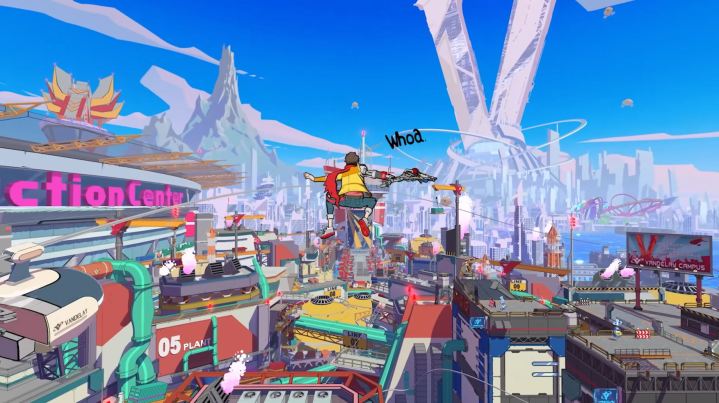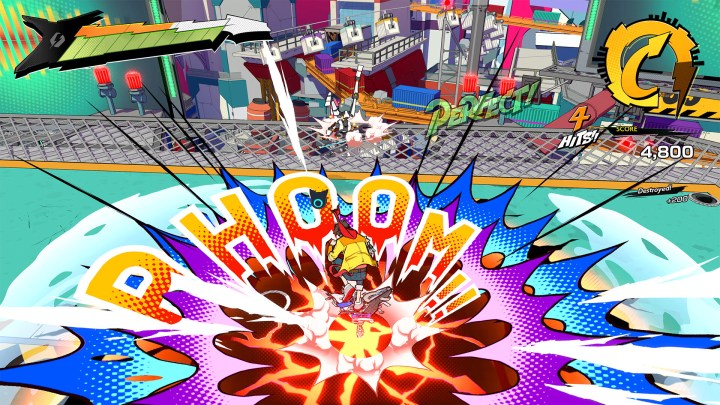
“Hi-Fi Rush cracks the rhythm-action genre wide open to deliver Tango Gameworks' most confident, stylish, and surprising project to date.”
- Rebellious spirit
- Fantastic musical combat
- Playful uses of rhythm
- Stylish visuals
- Effective soundtrack
- Pacing quirks
As I fight my way through waves of robots in Hi-Fi Rush, stylishly slashing them with my guitar in time with an energetic music track, I suddenly flash back to an Instagram reel.
Last year, the app’s unknowable algorithm briefly decided that it should only serve me reels from music teachers (a passive-aggressive move, if you ask this self-taught guitarist). For a few weeks, all of them seemingly latched onto the same trend as they put out quick videos highlighting the difference between beat and rhythm, two specific terms that get mistakenly interchanged with one another. In one clip I stopped to watch, the teacher starts by pointing out a song’s beat, steadily tapping out its tempo like a metronome. Then, she switches over to the rhythm, replicating the actual pattern of notes that weave around that tempo.
While some music games could stand to learn a thing from that video, Hi-Fi Rush is a model student. Tango Gameworks’ rhythm-action game, which surprise-launched on PC and Xbox last week, doesn’t just throw players a good playlist and ask them to keep time over it. Rather, everything about it is built around that music, like a band naturally locking in after a drummer’s opening count-in. Steady beats serve as an invisible force that powers its vibrant cyberpunk world, but I can hardly ever feel that restriction in a musical quest that plays like a creative improv session.
Hi-Fi Rush rockets to the top of the rhythm-action genre thanks to a stellar combat system that goes far beyond simple beat-matching. It has all the style of an anime, the long-lost creative energy of a GameCube game, and the bright-eyed exuberance of a 2000s teen at their first indie rock show. It’s the rare major studio game that breaks free from the monotony of a stagnating medium to deliver something that truly, earnestly rocks.
Putting the punk in cyberpunk
Narratively, Hi-Fi Rush is a cyberpunk game wrapped up in cartoon aesthetics. Set in a metropolis run by an oppressive megacorporation, the story focuses on a worker named Chai who’s deemed defective after having a music player fused to his chest. That kicks off an alt-rock-fueled journey to take down the company’s top brass with the help of some allies and a metallic guitar blade.
Hi-Fi Rush itself feels like a rejection of the capitalistic restrictions that major studios like Tango Gameworks often face.
Though its story can be a bit “anti-capitalism 101” at times — and loaded with the same quippy humor that plagues games like Forspoken — much of its narrative decisions work in the context of its light aesthetic. Biting satire is baked into its colorful world, as it makes some heavy themes more digestible for a range of age groups. The dystopia is filled with corporate propaganda posters and lore logs that paint a picture of the world’s exploited working class via loaded gags. One of my favorite text logs is a poem written by a maintenance robot forced to ceaselessly clean company floors that never get dirty. It’s a message that feels especially relevant to the year it’s releasing in, as the gaming industry inches closer to mass unionization.
That theme isn’t just reflected in its story. Hi-Fi Rush itself feels like a rejection of the capitalistic restrictions that major studios like Tango Gameworks often face. It’s not a run-of-the-mill AAA game featuring an expansive open world and obsessive hooks meant to keep consumers logging in (one could argue that Tango’s own Ghostwire: Tokyo fell victim to some of those trappings). It’s an entirely unique fusion of rhythm and hack-and-slash action, turning Devil May Cry into a music game. Even its art style rebels against modern instincts, opting for vibrant colors and an illustrative style rather than chasing “next-gen” realism.

During my playthrough, I frequently flashed back to the golden days of the Nintendo GameCube — a console that was loaded with the kind of eclectic games that you’ll only find in the indie scene these days. I’m transported to playing Capcom’s Viewtiful Joe as a kid, still impressed by how games could offer such a diverse range of play styles and visuals that I’d never experienced before. That’s slipped away from the big budget scene in the last decade as I’ve felt the biggest releases homogenized around the same general ideas. Rather than chasing bankable trends, Hi-Fi Rush prioritizes invention above all.
When you’re making a AAA video game that’s going to be positioned as a major console exclusive for a company like Microsoft, that’s perhaps the most punk thing you could do.
Playing with music
Hi-Fi Rush excels in a lot of areas, but its musical combat is its standout accomplishment. On paper, it’s your standard hack-and-slash where players build up massive combos (see: Bayonetta, Devil May Cry, etc). The twist, though, is that players do more damage if their attacks line up with the beat of the background music. Many games have tried this in recent years to varying degrees of success. Metal: Hellsinger, for instance, attempts to turn Doom into a rhythmic shooter, but its restrictive beat-matching system leaves little room to experiment with the music.
That’s not the case here as Tango Gameworks lays out a blueprint for others to follow. Here are the basics of battle: players can execute a light attack that lasts one beat or a heavy attack that lasts two. Through the game, Chai learns a long list of combos that mix the two up, discouraging players from simply pressing X on every single beat. A successful combo triggers a special move which is executed by nailing a quick button timing event. If I wanted to get better ratings in battles, I’d have to learn the rhythmic nuances of each combo string and employ them in battle like a guitarist pulling from their bag of tricks.
In my best battles, I feel just as much like a conductor as I do an action hero.
I’ve never been a guy who memorizes combo lists and fights with precision in games like this; I easily became that guy in Hi-Fi Rush. That’s the brilliance of the music system here. I’m not left trying to recall complex button strings on the fly. I know what every one of my attacks sounds and feels like. The timing of each one leaves more of an impression on me than a menu showing me the buttons. It’s so impactful that I feel like it’s going to change the way I approach the genre from now on, treating attack strings as riffs.
That setup would be enough to leave me impressed, but Hi-Fi Rush goes far beyond that without ruining its elegance. By the end, Chai can perform an evasive dash, parry attacks, tether towards an enemy, and summon companions to pepper in special attacks. Each one builds the soundscape as much as it adds complexity to battle. When players call in Peppermint, she’ll blast robots with her laser pistols and break blue shields, adding a unique bit of syncopation for a few beats. I found myself using my tether almost like a note rest, allowing me to quickly refocus my attention on an enemy before firing up a new bar of attacks. The fact that I can easily juggle so many moves by knowing how they play into the rhythm speaks volumes about the system’s power. In my best battles, I feel just as much like a conductor as I do an action hero.

Those ideas are built on further with a touch of customization, as Chai can purchase and equip guitar picks to gain passive boosts. It’s the one system I wish I had more time to play around with. Players earn gears, the game’s primary currency, by exploring levels, but larger quantities of them are earned by turning in achievements at a home base hub between missions. Since chapters tend to go on for close to an hour and don’t always end in a return to the base, I found that I only ever had a few opportunities to earn and cash in those large gear caches during my eight-hour playthrough. It’s a bit of odd pacing for a game that’s otherwise so fast-paced.
Though I’ve mostly focused on combat here, rhythm is baked into every part of Hi-Fi Rush. On-rail segments have Chai avoiding cargo crates by dodging side to side, larger enemies can be finished off in a Simon Says parry minigame, and platforming between arena battles requires some careful timing. Even when I’m dashing around levels looking for health upgrades or collectible graffiti, I find myself naturally dashing to the music, switching up my cadence just for the fun of changing up my sound pattern. Interactions like that make Hi-Fi Rush feel like the ultimate rhythm game, one that encourages me to play with the music no matter what I’m doing.
Style and substance
Hi-Fi Rush immediately stands out for its cartoon art style, which absolutely pops on Xbox Series X. Vibrant colors, bold line work, and smooth performance make it one of the best-looking games on current-gen consoles, trading in detailed realism for illustrative perfection. Though what’s more impressive than visual fidelity is how functional its aesthetic choices are.
I’m convinced I could mute it and still stay on beat.
For instance, every element of its levels is painstakingly animated to groove alongside the soundtrack. Pistons pump on beat when I’m zooming through a factory, while elevators drop to their destination in a staggered rhythmic pattern. Everything feels as if it’s dancing — and that’s not just for show. All of that acts as a natural visual indicator that keeps players on the beat even when they’ve lost the music. While a traditional beat-matching prompt can be toggled on with the press of a button, I played the entire game without it. I’m convinced I could mute it and still stay on beat.
I wouldn’t dare do that though, as the soundtrack itself offers some mid-2000s delight. In addition to an original soundtrack of energetic rock tunes, Hi-Fi Rush includes some solid licensed music that’s thoughtfully integrated into battles. In one standout fight, I go toe-to-toe with a boss as a cover of The Flaming Lips’ Free Radicals plays. I’m playing along to its primary verse until I whittle down one segment of the health bar. Suddenly, the song naturally transitions to its chorus, with the boss unleashing some new attacks and patterns to learn. In one section, the screen locks to a 2D plane as she tosses pipes at me, each one adding an extra guitar stab to the mix.

Mileage may vary when it comes to the soundtrack. I imagine some younger players might find tunes like Zwan’s Honestly or The Black Keys’ Lonely Boy not terribly indicative of the rebellious youth culture the game portrays. Even so, the music choices are undeniably functional. They bring the right brand of rock and roll energy while giving Chai some sturdy foundations to jam over during battle. Sure, this 33-year-old critic’s ears perked up when I heard the first notes of Fiona Apple’s Fast As You Can open a boss fight, but it makes for a tremendously exciting battle theme even if you’re unfamiliar with it.
Those left-field music choices reinforce what makes Hi-Fi Rush work so well: There are no compromises here. It feels like an earnest piece of self-expression from Tango Gameworks, rather than a project engineered for profit. It feels like the team behind it is banking on the hope that if it means something to them, then there will be an audience that connects with it too.
If that’s the case, they’re right. I’m that audience and I haven’t been so won over by a game of this scale in a very long time.
Hi-Fi Rush was reviewed on an Xbox Series X hooked up to a TCL 6-Series R635.
Editors' Recommendations
- Bethesda finally confirms that Hi-Fi Rush is coming to PS5
- One of the year’s best reviewed games is coming to Xbox Game Pass
- Former PS5 exclusive Ghostwire: Tokyo Comes to Xbox Game Pass in April
- Xbox Game Pass adds Lego Star Wars and a former Switch console exclusive
- Xbox exclusive High On Life delayed to December due to bugs




